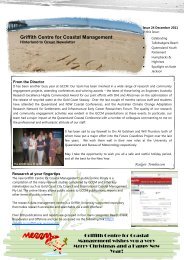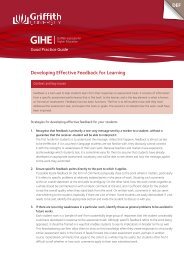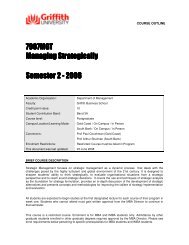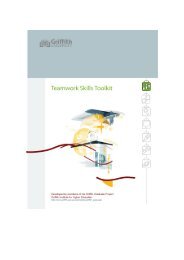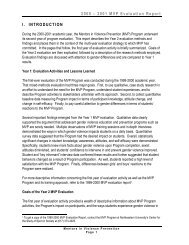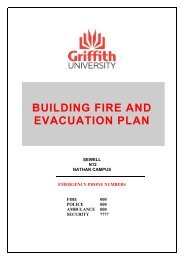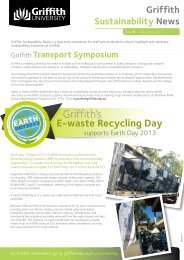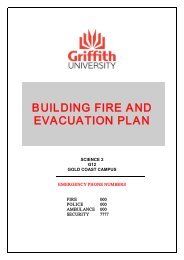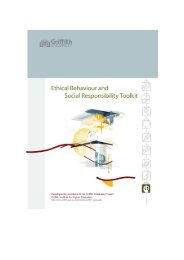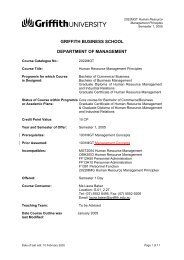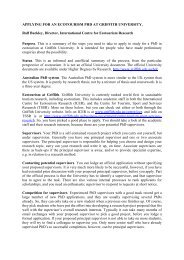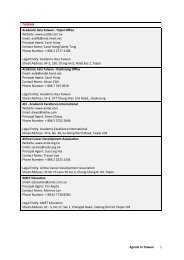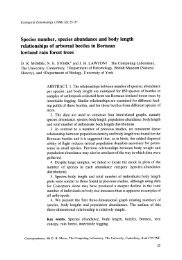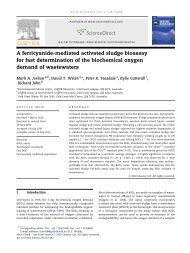3519QCA Furniture Design Semester 2 Semester ... - Griffith University
3519QCA Furniture Design Semester 2 Semester ... - Griffith University
3519QCA Furniture Design Semester 2 Semester ... - Griffith University
You also want an ePaper? Increase the reach of your titles
YUMPU automatically turns print PDFs into web optimized ePapers that Google loves.
Academic Organisation: Queensland College of Art<br />
Faculty: Queensland College of Art<br />
Credit point value: 10<br />
Student Contribution Band: Band 1<br />
Course level: Undergraduate<br />
Campus/Location/Learning Mode: South Bank / On Campus / In Person<br />
Convenor/s: Mr Sam Di Mauro (South Bank)<br />
Enrolment Restrictions: Restricted: Approval from Head of School<br />
This document was last updated: 23 July 2007<br />
BRIEF COURSE DESCRIPTION<br />
COURSE OUTLINE<br />
In this course students will develop an understanding of furniture design by studying methods of<br />
manufacture, materials, history and the principles of furniture design in order to complete two furniture<br />
design projects. These projects will involve concept design, plans, form studies and a final model of the<br />
piece. Assessment will be progressive, based on journal and presentations.<br />
Restriction: Student must be enrolled in a QCA or GFS Program
SECTION A – TEACHING, LEARNING AND ASSESSMENT<br />
COURSE AIMS<br />
<strong>3519QCA</strong> <strong>Furniture</strong> <strong>Design</strong><br />
<strong>Furniture</strong> is a manufactured product closely integrated with the needs of the human environment,<br />
culture and everyday life. Basic principles such as ergonomics and structure must be referenced<br />
and understood before any furniture piece can be successfully designed. Once the basic principles<br />
have been realized, the application of research, to understand ritualistic and demographic needs<br />
considered, an innovative and highly relevant product is designed.<br />
This course will study the major aspects of furniture design with an emphasis on research to inspire<br />
creative thinking, providing students with a sound understanding of furniture design principles and the<br />
ability to design for one off applications or mass production.<br />
This course is important to those students who wish to add furniture to their portfolio of design skills,<br />
however as furniture plays an important role in other areas such as set design, sculpture and other<br />
creative areas, the course could also be suitable for students from these disciplines.<br />
The main emphasis in this course is one of seeking out and identifying with furniture needs which are not<br />
being given sufficient consideration in contemporary society.<br />
LEARNING OUTCOMES<br />
IIn this course students will develop an understanding of furniture design by studying methods of<br />
manufacture, materials, history and the principles of furniture design in order to complete two furniture<br />
design projects. These projects will involve concept design, plans, form studies and models.<br />
The learning outcomes are as follows:<br />
1 An ability to research a situation in order to interpret a need.<br />
2 To proceed through a process of generating ideas which respond innovatively to the needs of<br />
the brief<br />
3 To refine a concept through to a design resolution<br />
4 To have a basic understanding of materials and furniture construction methods.<br />
5 To make a scale model of the furniture piece.<br />
CONTENT, ORGANISATION AND TEACHING STRATEGIES<br />
The elements and principles of furniture design and how furniture is situated historically are important<br />
aspects of this course.<br />
From an academic perspective the brief will be defined through broad based research into cultural<br />
changes and demographic shifts. From a practical perspective students will research manufacturing<br />
techniques, materials and jointing methods. the forces acting on furniture, stress, strain, bracing<br />
techniques and ergonomics. Armed with this information students in consultation with the lecturer, will<br />
design two pieces and develop them through to a scale model or prototype.<br />
1
This subject will be conducted over one semester, with each project arranged in three stages<br />
1- Research Generic leading to more specific/focused research,<br />
2- Concept Generating innovative responses to the problem.<br />
3- <strong>Design</strong> Resolution.Resolving the design using more specific and direct research into materials and<br />
construction methods.<br />
Content Rationale<br />
This subject is designed to give students a general grounding in the area of furniture design and<br />
construction. It will develop investigatory research into innovative and practical solutions for one off or high<br />
run production.<br />
Organisation & Teaching Methods<br />
Weekly contact will be three(4) hours.<br />
Lectures of about one hour duration will be followed by studio sessions of two (3) hours. A research<br />
journal will be kept for final assessment in week thirteen(13).<br />
Teaching will be by lecture, seminar and demonstration and through participation in practical studio<br />
exercises with supporting theoretical presentations and group critiques. Students will be set work to<br />
include practical and personal research exercises to be carried out in the studio and in their own time.<br />
A 90% minimum attendance at studio sessions will be required.<br />
Students completing this course will have a sound knowledge of materials and their construction methods<br />
in the context of furniture design.<br />
CONTENT SUMMARY<br />
PRINCIPLES OF FURNITURE DESIGN SEMESTER PROGRAM 2007<br />
S.M. Di Mauro QCA Southbank<br />
TOPIC PROJECT STAGES<br />
WEEK<br />
SemWt<br />
1<br />
2<br />
3<br />
4<br />
5<br />
6<br />
7<br />
8<br />
<strong>Furniture</strong> then, Now &……..<br />
• Intro.Proj. 1.-70% sem.Award<br />
• Materials & Construction<br />
• An overview of materials and furniture<br />
construction methods.<br />
• Intro. Proj. 2, 30% of sem. Award<br />
• Product-‘ambience board of self’<br />
• <strong>Furniture</strong> Statements<br />
• The unique one off approach to<br />
furniture design<br />
• Jointing methods<br />
• Hand made and mechanical methods of<br />
constructing furniture<br />
• Brainstorming for project 2<br />
• <strong>Furniture</strong> & applied forces<br />
• Stress factors effecting furniture<br />
• Fixing systems<br />
• Visit –by/to Hafele Australia to be<br />
confirmed<br />
• Ergonomics<br />
The measure of persons applied to furniture<br />
to function successfully<br />
• <strong>Design</strong> for mass production<br />
• Field trip to be confirmed.<br />
• Concept Presentation Project 2<br />
Assignment 1 – Introduction<br />
Research Proj 1<br />
Research Interpretation of self brainstorm<br />
Ongoing Research Proj 1<br />
Preliminary discussion of Research<br />
direction for Project 1<br />
Concept selection &<br />
development Project 2<br />
Write your own brief for Project 1<br />
Brief to be emailed to me before the<br />
next lecture.<br />
s.dimauro@griffith.edu.au<br />
Field Trip<br />
Research/verbal concept orientation, and<br />
brief presentation Proj 1<br />
Brief Analysis Project 1<br />
Make Model or prototype of<br />
Concepts for Project 2<br />
Concept Presentation Project 2<br />
Proj<br />
Wt<br />
20%<br />
part wtg<br />
Proj 2<br />
Wt<br />
2
9<br />
10<br />
11<br />
12<br />
13<br />
• Metals Visit by Ronstan/stainless steel<br />
fittings -architectural, marine and shop<br />
fitting industries.<br />
• Wood & re-processed fibre.GC only<br />
Wood as a construction and base material<br />
for fabricated boards<br />
Brainstorming Project 1<br />
30%<br />
Presentation of concept project 1 Proj<br />
wt<br />
20%<br />
• Plastics Concept Development Project 1<br />
Glass Applications & limitations<br />
Finishing<br />
Concept Development Project 1<br />
Resolved design presentation Resolved design presentation Proj<br />
Wt<br />
30%<br />
The course endeavours to continually reflect on social issues which reflect on lifestyle and place.<br />
ASSESSMENT<br />
Summary of Assessment<br />
ASSESSMENT<br />
There are two projects. Project 1 dealing with issues of mass production, this will have a weighting of 70%<br />
of the semester award, Project 2 will deal with one off production and will have a semester weighting of<br />
30%.<br />
The method of assessment will be progressive over the semester, based on a journal and project<br />
presentations.<br />
There will be two projects Project 1 will run for the entire semester with Project 2 being completed between<br />
Weeks 2 and 10. Students will keep a journal informed by the lectures and the design processes<br />
undertaken through out the semester. This document will be presented in the last week of the semester.<br />
Group critiques will be conducted at various intervals throughout the projects unless otherwise stated ie.<br />
Project 1 will have three points of presentation namely Research Week 6, Concept Week 10. and <strong>Design</strong><br />
Resolution Week 13.<br />
Note: The projects have been designed to overlap to allow for more time to conduct market research and<br />
comprehensive research into contemporary lifestyle, demographic and cultural needs for Project 1.<br />
Project (1) Research 30<br />
Concept & development 30<br />
Resolution of design 40<br />
Project (2) Research 20<br />
Assessment criteria:<br />
Research Presentation<br />
Concepts & development 50<br />
Resolution of design 30<br />
Evidence of research & Investigation<br />
3
Depth and scope of research<br />
Relevance of information<br />
Concept Presentation<br />
Creativity and innovation<br />
Material usage<br />
Oral presentation<br />
Visual presentation<br />
<strong>Design</strong> synthesis<br />
<strong>Design</strong> Resolution<br />
Function<br />
Originality<br />
Structural resolution<br />
Construction comprehension<br />
Attention to detail<br />
<strong>Design</strong> synthesis<br />
Presentation Package<br />
Clarity & technique of presentation<br />
Technical skill<br />
Presentation layout<br />
Application of research<br />
<strong>Design</strong> innovation / idea expression<br />
Model accuracy and finish<br />
Assessment Rationale<br />
Progressive assessment, in conjunction with the group seminars and critiques, will develop self evaluation<br />
abilities enabling students to upgrade and improve work. Criteria for evaluation of student skills and<br />
knowledge will be as follows:<br />
• originality<br />
• innovation<br />
• ergonomics<br />
• function<br />
• practicality of manufacture.<br />
Return of Assessment Items<br />
All assessment items will be available for collection three weeks after final submission<br />
Notification of Availability of Feedback on Assessment<br />
Feedback will be given at each stage of assessment, (with the exception of the final presentation in which<br />
case a feedback sheet will be available from your lecturer), During group cretiques in the studio or on site<br />
oral feedback will only be given at this time it is highly recommended that the student make a note of<br />
comments from peers and lecturing staff or arrange for notes to be taken by one of their peers. Or<br />
alternatively a recorder may be used. This feedback is used to assist the student to take the project further<br />
along the course of its development.<br />
GRADUATE SKILLS<br />
The <strong>Griffith</strong> Graduate Statement states the characteristics that the <strong>University</strong> seeks to engender in its<br />
graduates through its degree programs.<br />
4
Graduate Skills<br />
Effective communication (written)<br />
Effective communication (oral)<br />
Effective communication (interpersonal)<br />
Information literacy<br />
Problem solving<br />
Critical evaluation<br />
Work autonomously<br />
Work in teams<br />
Creativity and innovation<br />
Ethical behaviour in social / professional / work environments<br />
Responsible, effective citizenship<br />
TEACHING TEAM<br />
Course Convenor<br />
Convenor Details QCA South Bank<br />
Campus Convenor Salvatore Di Mauro<br />
Email s.dimauro@griffith.edu.au<br />
Office Location Webb Building Level 4 Room 4.29<br />
Phone 07 3735 3154<br />
Fax 07 3735 3159<br />
Consultation times A one hour consultation period by appointment only.will follow the class<br />
COURSE COMMUNICATIONS<br />
The preferred mode of communication outside of class and consultation times is by email.<br />
TEXTS AND SUPPORTING MATERIALS<br />
This course is studio based and relies heavily on the students ability to communicate through the mark<br />
making process. While it is not necessary to be able to draw like ‘The Old Masters’, it is essential that the<br />
student develop visual communication methods that translate their thoughts with resonable accuracy.<br />
Necessary equipment and materials include the following:<br />
Hard cover, bound A4 or A3 Journal, a Stadler 96180-2AS. scale rule with 1:5, 1:10, 1:25 scales, Butter<br />
Paper (or a role of grease proof lunch wrap from the supermarket), coloured pencils preferably water<br />
soluble, HB, 2B and 6B graphite pencils, black felt pens Nos. 3, 5 and 8. cutting knife, scissors, A4 or A3<br />
cutting mat, invisible tape, glue for paper and card, stainless steel 600mm straight edge/ruler, 3-4m<br />
Taught<br />
Practised<br />
Assessed<br />
5
measuring tape, it is desirable but not essential to have a digital camera with the necessary cables to<br />
down load images associated with research and site visits to your computer.<br />
Bibliography<br />
Datschefski.E. The Total Beauty of Sustainable Products Rotovision Switzerland, 2001<br />
Papanek, V The Green Imperative:Natural <strong>Design</strong> for the Real World,Thames and Hudson<br />
Lovins, A. Lovins, H. Hawken, P. Natural Capitalism: Creating the Next Industrial<br />
Revolution.Little and Brown 1999<br />
Dormer, P. An Illustrated Dictionary of 20th Century <strong>Design</strong>ers Mallard Press, New York NK 1165 . I<br />
44 1991<br />
Domergue. D Artists <strong>Design</strong> <strong>Furniture</strong> H. M. Abrams. New York. TS 885 . D68 1984<br />
Marzano,S.Creating Value by <strong>Design</strong>Thoughts Royal PhilipsElectronics Pub. The Netherlands, 1998<br />
Leadbeatter & Keable. Australian Woodworking. McGraw Hill Sydney 1974<br />
Krenv.J.A . Cabinet makers Notebook. Van Nostrand Rienhold New York 1983<br />
<strong>Design</strong>ing for Recreation and Leisure. Clubs and Resorts. PBC International, Inc. NA 2543. R43. C58<br />
1993<br />
Mahnke, F.H. & R.H. Colour And Light In Man-Made Environments. Van Nostrand Rienhold New York<br />
BF 789 . C7 M24 1987<br />
Dunham / Zimmerman Details of Frank Lloyd Wright. The California Work, 1909- 1974. Chronicle Books.<br />
San Francisco. NA 737 .W7 D86 1994<br />
Proshansky, H. (1976) Environment Psychology: People and their Physical Settings. (2nd Ed.) New<br />
York: Holt, Rinehart & Winston.<br />
Ettore Sotlsass. Furnature & a Few Interiors. Gambonet, G Philippe Daverio. Milano 1985<br />
Hattori, H. (1988) How to Understand and Use Display. Tokyo: Graphic-sha.<br />
Belk, RE.W. “Attachment to Possessions.” in I.Altmann and S.M. Low (eds.), Place<br />
Attachment. New York: Plenum Press, 1992, pp. 37-62.<br />
MATSUI, K. (1987). Three Dimensional Graphics. Japan: Rikuyo-sha Publishing.<br />
Sparke P. <strong>Furniture</strong>, Unwin Hyman Limited, London Sydney NK2395 . S6 1986<br />
McCraken, G. Culture and Consumption: New Approaches to the Symbolic Character of<br />
Consumer Goods and Activities. Bloomington: Indiana <strong>University</strong> Press, 1988.<br />
Different. N . Human Scale 1/2/3. MIT Press Massachusetts TA 166 . D5 1979<br />
Panero,J. & Whitney,M.Z Human Dimensions and Interior Spaces. Library of Congress 1979<br />
Field. D. Projects In Wood. G. P. Puntnam’s Sons New York. ISBN 0-399-13089-6 1985<br />
Nakashima. G. Soul Of A Tree. Kodansha. Tokyo TT 200 . N3 1981.<br />
Branzi, A. The Hot House Italian New Wave <strong>Design</strong>. The MIT Press Italy 1984<br />
The Story of Western <strong>Furniture</strong> Bennett, R<br />
Herbert London 1981<br />
Wills, A-M & Tonkin, C. Timber in Context a guide to sustainable use. Construction<br />
Information Systems. 1998 Milsons Point NSW<br />
Charlotte & Peter Fiell, 1000 Chairs, Taschen Koln 1997<br />
Ashcroft, R. (1985) Construction for Interior <strong>Design</strong>ers. London: Longman Scientific and Technical.<br />
Bachelard, Gaston. The Poetics of Space. New York:Orion Press, 1984.<br />
Juhani Pallasmaa. Polemics, The Eyes of the SkinArchitecture and the Senses. Academy<br />
Editions 1996<br />
Rahim, A. Contemporary Techniques in Architecture.Wiley –Academy London Vol 72 No 1<br />
Jan 2002<br />
Heathcote,E. <strong>Furniture</strong> and Architecture Wiley –Academy London Vol … No .. Aug 2002<br />
Castle,H. Fashion + Architecture. Wiley –Academy London Vol 70, No 6, Dec 2000<br />
Kaplick,J. Looking Back in Envy. Wiley –Academy London Vol 71. No 5, Sept. 2001<br />
Byars, M. 50 Chairs Innovations in <strong>Design</strong> and Materials.Pro <strong>Design</strong> Series. Roto Vision SA England<br />
Byars, M. 50 Lights Innovations in <strong>Design</strong> and Materials.Pro <strong>Design</strong> Series. Roto Vision SA England<br />
Byars, M. 50 Products Innovations in <strong>Design</strong> and Materials.Pro <strong>Design</strong> Series. Roto Vision SA<br />
England 1998<br />
Byars, M. 50 Sports Wares Innovations in <strong>Design</strong> and Materials.Pro <strong>Design</strong> Series. Roto Vision SA<br />
England 1999<br />
Van Onna, Edwin. Material World Innovative Structures and Finishes for Interiors. Frame Birkhauser.<br />
Frame Publishers Amsterdam 2003<br />
6
Australian Standards for <strong>Furniture</strong> <strong>Design</strong> and Manufacture<br />
Australian Bureau of Statistics Ph 1300 135 070 http://www.abs.gov.au/Ausstats/abs@.nsfm kjjmmm jjjnb<br />
gcvfd<br />
PERIODICALS<br />
Domus NK 1700 . D 6<br />
Fine Woodworking Techniques (Annual) The Taunton Press. Connecticut.1982<br />
Wallpaper. Published by Time Life Entertainment Group, London. www.wallpaper.com<br />
Interni NK 2200 . I 57<br />
The Book 2006, Info-Link or The Book CD 2006 or<br />
The Book 2006 web site www.infolink.com.au<br />
Volvo grey and black list of compounds<br />
www.tech.volvo.se/standard/docs/10092.pdf,10091.pdf and 100911.pdf<br />
Product Storytelling to create a vision of the future<br />
www.imaginaction.org.uk<br />
The Centre for Alternative Technology Wales guidance on setting up small scale energy and<br />
waste system. www.cat.org.uk<br />
Green Architecture Bill McDonough www.mbdc.com<br />
The Centre for Sustainable <strong>Design</strong> www.cfsd.org.uk<br />
Focusing on the products of the developing world UNEP Sustainable Product group has a<br />
database of product examples and has built an extensive network of eco-design practitioners<br />
throughout the world. www.unep.frw.uva.nl<br />
Flexible Wood www.bendy wood.com<br />
Photo Chromic Dyes www.james-robinson.ltd.uk<br />
Anti-microbial Fibre www.x-static.com<br />
Flexible Electronic Fabric www.eleksen.com<br />
Solar Modules www.sunovation.de<br />
Liquid-Crystal Windows www.saint-gobain.com<br />
Self Healing Polymer www.autonomic.uiuc.edu<br />
Self Cleaning Glass www.pilkington.com/building/world/bpna/newsroom.html<br />
Climate Control Fabric www.schoeller-textiles.com<br />
Colour Changing Plastic www.ips-srl.it<br />
Thermo Plastic Wood www.treeplast.com/technical_specifications.htm<br />
Palm Flooring www.durapalm.com<br />
Bio-degradable Plastic www.biopolymer.net<br />
Recycled Polyethylene www.yemmhart.com<br />
Colour Shifting Thermo-plastic Film www.sommers.com<br />
Led Light Panels www.emdelight.com<br />
Lenticular Film with Chromatic Effect<br />
3-D Objects in Polymer www.skydesign.com<br />
Interactive Light Floor<br />
Colour Variable Pigment www.basf.de<br />
Retro Reflecting Prismatic Film www.reflexite-europe.com<br />
Special Effects Thermo Plastics www.geplastics.com<br />
View Control Film www.madico.com<br />
Holo-graphic Projection Screen www.holopro.com<br />
Flourescent Glass Tiles www.schott.com<br />
Illusive Film www.illusionflex.com<br />
Inter-layer for Laminated Glass www.vanceva.com<br />
Soft Tile www.saar.nl<br />
Chromatic Fabrics www.sommers.com<br />
Intelligent Gel Foam www.edizone.com<br />
7
Power-Stretch Fabric www.schoeller-textiles.com<br />
Fibreglass Textile www.parabeam3d.com<br />
Metal Weaves www.gdk.de<br />
Metallised Plastic Film www.aerospace-technology.com/contractors/thermal/trico<br />
Or www.dupontteijinfilms.com<br />
Sculptural Aluminium Sheets www.forms-surfaces.com<br />
Stainless Sheer www.clarencehouse.com<br />
Heat Shrink Tubing www.nationalstandardparts.com<br />
Corrugated Board www.well.de<br />
Super Strong Fibre www.dyneema.com<br />
Inflatable Wall www.braunwagner.de<br />
Aesthetic Entrance Flooring www.bonarfloors.com<br />
Fibre Reinforced Composite System www.fyfeco.com<br />
Climate Control Screens www.ludvigsvensson.com<br />
Metal Sandwich Sheet www.laminatesandcomposites.com<br />
Honeycomb Foam www.sekisui.co.jp<br />
Light Weight Energy Absorber www.cellbond.com<br />
Porous Construction Material www.tenberge.nl<br />
Shock Absorbing Foam www.swisstex.com<br />
Translucent Honeycomb Panel www.e-panelite.com<br />
Laminated Glass Sheets www.saint-gobain.com<br />
Very high Bond Tape www.3m.com<br />
Translucent or Transparent Concrete billpprice@hotmail.com<br />
Injection Moulded Magnesium www.bernhardtdesign.com<br />
Composite Glass Flooring www.cellbond.co.uk<br />
High Density Wqood Fibre-board www.wogg.ch<br />
Honeycomb Paper Board, BeeBoard www.besin.com<br />
Stabilised Aluminium Foam Alusion www.alusion.com<br />
Tensioned Membrance Sheerfill www.birdair.com<br />
Mouldable Honeycomb Sheet Material www.heideveld-polyester.nl<br />
Stretch Ceilings www.barrisol.com<br />
Foldable Poly-Propylene Sheeting www.polyline.be<br />
Stereo Litho-graphy www.dsmsomos.com<br />
Cocoon Spray www.droogdesign.nl<br />
Fabric Layered Foam www.alveo.com<br />
Selective Laser Sintering www.materialise.be or www.ronarad.com<br />
Metal Injection Moulding www.comotec.com<br />
Patterned sheets Sicobloc www.mazzucchelli1849.it<br />
Drop Tile www.tichelaar.nl<br />
Aromatic Ink www.matsui-color.com<br />
Copper Plated Fabric www.schlegel.be<br />
Magnetic Tile www.dalsouple.com<br />
Woven Vinyl Flooring www.bolon.se<br />
Durable Wall Covering www.trespa.com<br />
Dry-erasable Writing Surface MemErase www.muraspec.com<br />
Photo Tiles www.tichelaar.nl<br />
Felt Materials NTDH www.claudyjongstra.com<br />
Metal Backed Tiles www.naturaltile.co.uk<br />
Abet Laminati www.abet-laminati.it<br />
Airframe Advanced Materials www.airframeusa.com<br />
Alcan www.alcan.com<br />
B!ipp Creative Facility www.bipp.nl<br />
DSM High Performance Fibers www.dyneema.com<br />
8
DuPont Teijin Films US www.dupontteijinfilms.com<br />
Reflexite Europa www.reflexite-europe.com<br />
Material website Selector.com, it is an architectural and design site that keeps you up to date with<br />
new products.<br />
Urban Ecology Australia www.urbanecology.org.au<br />
Australian Green Development Forum www.agdf.org.au<br />
Alternative Technology Association www.ata.org.au<br />
A coalition of green building industry professionals www.healthybuilding.net<br />
The Not So Big House by Sarah Susanka pub Taunton in 1998 www.notsobighouse.com<br />
The Wilderness Society One Stop Timber Shop www.timbershop.wild.net.au<br />
Ecospecifer www.ecospecifier.org<br />
The Society of Responsible <strong>Design</strong> www.green.net.au/srd<br />
Environmental information for Queensland www.epa.qld.gov.au<br />
The Allergy, Sensitiviy and Environmental Health Association www.asehaqld.org.au<br />
Bill Moyers Trade Secrets coming clean www.come-clean.org<br />
Repeat Products www.repeatproducts.com.au<br />
Biodegradable products from corn and sugarcane www.simplybiodegradable.com<br />
Informe<strong>Design</strong> http://www.informedesign.umn.edu<br />
SECTION B – ADDITIONAL COURSE INFORMATION<br />
Students should refer to the Learning@<strong>Griffith</strong> website for further information about this course<br />
9
SECTION C – KEY UNIVERSITY INFORMATION<br />
ACADEMIC MISCONDUCT<br />
Students must conduct their studies at the <strong>University</strong> honestly, ethically and in accordance with accepted<br />
standards of academic conduct. Any form of academic conduct that is contrary to these standards is<br />
academic misconduct, for which the <strong>University</strong> may penalise a student. Specifically it is academic<br />
misconduct for a student to:<br />
present copied, falsified or improperly obtained data as if it were the result of laboratory work, field<br />
trips or other investigatory work;<br />
include in the student's individual work material that is the result of significant assistance from<br />
another person if that assistance was unacceptable according to the instructions or guidelines for<br />
that work;<br />
assist another student in the presentation of that student's individual work in a way that is<br />
unacceptable according to the instructions or guidelines for that work;<br />
cheat; (Cheating is dishonest conduct in assessment);<br />
plagiarise (Plagiarism is knowingly presenting the work or property of another person as if it were<br />
one's own.)<br />
Visit the <strong>University</strong>’s Policy on Academic Misconduct for further details.<br />
PLAGIARISM DETECTION SOFTWARE<br />
In semester 2, 2007 the <strong>University</strong> is piloting the use of plagiarism detection software. Students should be<br />
aware that your Course Convenor may use this software to check submitted assignments. If this course is<br />
included in the pilot your Course Convenor will provide more detailed information about how the detection<br />
software will be used.<br />
KEY STUDENT-RELATED POLICIES<br />
All <strong>University</strong> policy documents are accessible to students via the <strong>University</strong>’s Policy Library website at:<br />
www.griffith.edu.au/policylibrary. Links to key policy documents are included below for easy reference:<br />
Student Charter Academic Standing, Progression and Exclusion Policy<br />
Student Administration Policy Policy on Student Grievances and Appeals<br />
Assessment Policy Examinations Timetabling Policy and Procedures<br />
Academic Calendar Guideline on Student E-Mail<br />
Health and Safety Policy<br />
UNIVERSITY SUPPORT RESOURCES<br />
The <strong>University</strong> provides many facilities and support services to assist students in their studies. Links to<br />
information about <strong>University</strong> support resources available to students are included below for easy<br />
reference:<br />
Learning Centres - the <strong>University</strong> provides access to common use computing facilities for educational<br />
purposes. For details visit www.griffith.edu.au/cuse<br />
Learning@<strong>Griffith</strong> - there is a dedicated website for this course via the Learning@<strong>Griffith</strong> student portal.<br />
Student Services facilitate student access to and success at their academic studies. Student Services<br />
includes: Careers and Employment Service; Chaplaincy; Counselling Service; Health Service; Student<br />
Equity Services (incorporating the Disabilities Service); and the Welfare Office.<br />
Learning Services within the Division of Information Services provides learning support in three skill areas:<br />
computing skills; library skills; and academic skills. The study skills resources on the website include selfhelp<br />
tasks focusing on critical thinking, exam skills, note taking, preparing presentations, referencing,<br />
writing, proof reading, and time management.<br />
10




